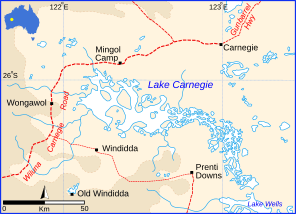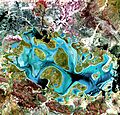Lake Carnegie (Western Australia) facts for kids
Quick facts for kids Lake Carnegie |
|
|---|---|
 |
|
| Location | Goldfields-Esperance, Western Australia |
| Coordinates | 26°10′S 122°30′E / 26.167°S 122.500°E |
| Type | Ephemeral |
| Basin countries | Australia |
| Max. length | 100 km (62 mi) |
| Max. width | 30 km (19 mi) |
| Surface area | 5,714 km2 (2,206 sq mi) |
| Surface elevation | 439 m (1,440 ft) |
Lake Carnegie is a very large lake in Western Australia. It's called an "ephemeral" lake because it only fills with water after heavy rain. Most of the time, it's dry or just a muddy area.
The lake is named after David Carnegie. He was an explorer who traveled a lot in inland Western Australia in the 1890s. Another similar lake, Lake Wells, is located to its southeast.
Contents
About Lake Carnegie
Lake Carnegie is mostly surrounded by desert. It is located east of Wiluna. The lake sits at the southern edge of the Little Sandy Desert. It also borders the southwestern part of the Gibson Desert.
The lake is about 100 kilometers (62 miles) long. At its widest point, it measures about 30 kilometers (19 miles) across. Its total area is around 5,714 square kilometers (2,206 square miles). This makes it one of the biggest lakes in Australia. The lake's surface is 439 meters (1,440 feet) above sea level.
When the Lake Fills
Lake Carnegie only fills with water during very rare times of heavy rainfall. This can happen during big floods, like the one in 1900. It also fills during tropical wet seasons. Sometimes, tropical cyclones move south due to climate change. This brings a lot of rain to the area.
In dry years, the lake shrinks down to a muddy marsh.
Big Rains in 1973
In 1973, a strong storm called Tropical Cyclone Kerry hit the northwest coast. It then moved south into the northern goldfields region. Nearby farms, called stations, received huge amounts of rain. For example, Windidda Station got 310 millimeters (12 inches) of rain. Prenti Downs received 209 millimeters (8.2 inches) over four days.
This caused massive flooding. The lake overflowed, and the area between Lake Carnegie and Wiluna became one giant lake.
How Water Enters the Lake
Unlike some other dry lakes in Australia, Lake Carnegie doesn't get water from clear river channels. The soil in this region is very old and worn down. This means there isn't much loose dirt or sediment. The land is also very flat. Because of this, proper river channels don't form easily. Also, the plants in the area have deep roots. This limits how much water runs off the surface into the lake.
Nearby Stations
The area around Lake Carnegie is home to several large farms. In Western Australia, these are known as "stations" or "pastoral leases." These include Windidda, Yelma, Wongawel, Niminga, Carnegie, and Prenti Downs stations. These stations are used for raising livestock.
Images for kids




